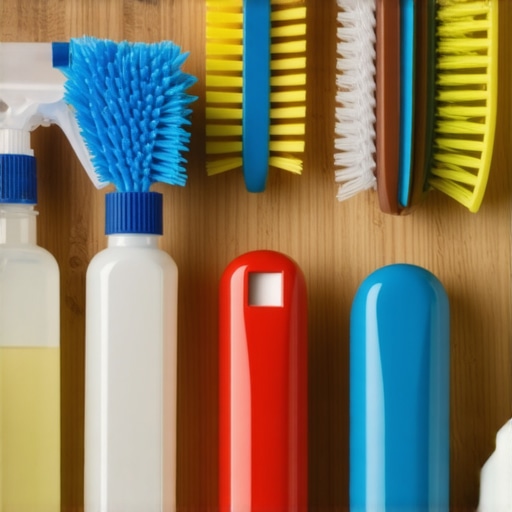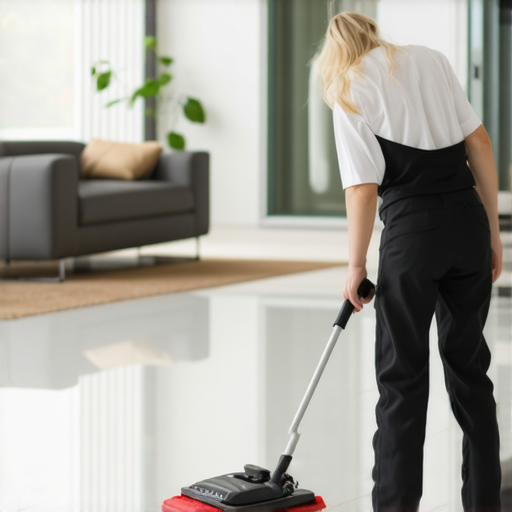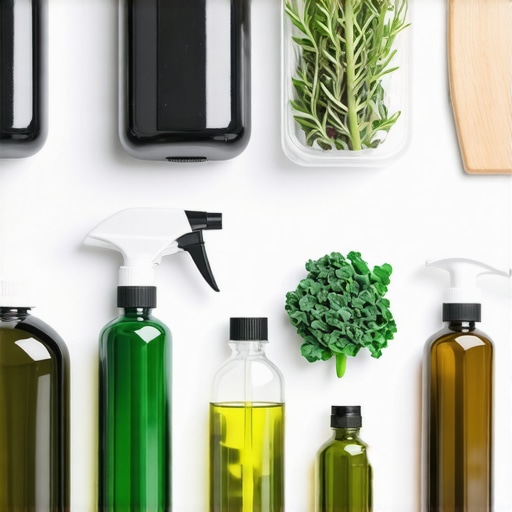My Journey into Eco-Conscious Post-Construction Sanitization
When I first stepped into my newly renovated home, I was overwhelmed by the lingering chemical smells and the stark, artificial cleanliness that felt more like a sterile hospital than a cozy living space. As someone passionate about sustainable living, I started exploring eco-friendly sanitization methods, eager to find solutions that were both effective and gentle on our planet. This personal journey opened my eyes to the importance of eco-conscious post-construction sanitization and how it can truly transform a space.
Why Eco-Friendly Cleaning Matters After Construction
After a construction project, the air can be filled with dust, volatile organic compounds (VOCs), and other pollutants. Traditional cleaning products often contain harsh chemicals that can linger in the air and impact our health. I learned that choosing eco-friendly solutions not only protects our environment but also creates a safer home environment for my family. According to the EPA, reducing chemical exposure is crucial for maintaining indoor air quality, especially after major renovations.
My Favorite Sustainable Cleaning Methods
One of the first steps I took was switching to natural cleaning agents like vinegar, baking soda, and lemon juice. These ingredients are powerful, biodegradable, and free from toxic fumes. I also invested in a HEPA-filter air purifier, which helps remove airborne dust and allergens, making the space healthier. For surfaces, I opted for eco-certified disinfectants that are effective yet gentle, aligning with my goal of sustainable living. Sharing this approach with friends, I often recommend checking out dedicated eco-friendly cleaning brands for their commitment to sustainability.
What Are the Key Benefits of Green Post-Construction Sanitization?
In my experience, the benefits extend beyond just environmental impact. Using green methods has noticeably improved the indoor air quality and reduced allergic reactions in my household. Plus, I feel good knowing I’m reducing my carbon footprint and avoiding the health risks associated with chemical cleaners. It’s a win-win situation that inspires me to keep exploring innovative, sustainable solutions for my home.
How Can You Start Your Eco-Friendly Post-Construction Sanitization?
What practical steps can I take to ensure my post-renovation space is truly eco-conscious?
Start with a thorough cleaning using natural ingredients, ventilate your space well, and consider investing in eco-certified disinfectants. Additionally, using air purifiers and choosing sustainable materials for further cleaning can make a significant difference. I encourage you to share your own experiences or ask questions about eco-friendly cleaning—let’s learn together! For more detailed tips, I found this helpful resource on sustainable cleaning methods that I highly recommend.
Remember, every small effort counts when it comes to creating a healthier, greener home environment. If you’re interested in more eco-friendly home tips, check out my favorite article on Eco-Friendly House Cleaning Hacks for a Greener Home.
Innovative Natural Disinfectants: Going Beyond the Basics
Building upon my initial switch to vinegar and baking soda, I started exploring more advanced eco-friendly disinfectants that are effective against a broad spectrum of pathogens yet safe for indoor use. For instance, plant-based disinfectants derived from essential oils like tea tree or eucalyptus have antimicrobial properties without the toxic residues of conventional products. These oils not only sanitize but also leave a pleasant, natural aroma, contributing to a healthier indoor environment. It’s fascinating how research from reputable sources like the Environmental Protection Agency highlights the efficacy of certain essential oils as disinfectants, reinforcing their validity in sustainable cleaning routines.
What Are the Nuanced Challenges of Eco-Friendly Post-Construction Cleaning?
While embracing green cleaning methods offers numerous benefits, it also presents unique challenges that require an expert’s nuanced understanding. For example, the residual dust and chemical residues from construction work can be stubborn, necessitating specialized cleaning techniques. Additionally, sourcing truly eco-certified products demands careful scrutiny of labels and certifications, such as EPA-approved biocides or third-party sustainability certifications. Balancing the need for rigorous sanitation with eco-conscious choices can sometimes be complex, especially in environments with sensitive populations like children or pets. This is why I advocate for a layered approach that includes not just natural cleaning agents but also strategic ventilation, HEPA filtration, and ongoing air quality monitoring, which are crucial for comprehensive post-renovation hygiene.
Including visual aids can significantly enhance understanding. For example, an image showcasing a well-organized eco-friendly cleaning station or a before-and-after of a sanitized space can inspire confidence and clarity in your approach. Visuals serve as practical references and motivate sustained commitment to sustainable practices.
How Can You Leverage Expert Knowledge for Sustainable Post-Renovation Cleaning?
What questions should I ask when selecting eco-certified cleaning products or consulting professionals?
Engaging with experts involves asking about product certifications, ingredient transparency, and proven efficacy. It’s beneficial to inquire whether the products have third-party validations, such as EPA Safer Choice labeling or Green Seal certification, which guarantee environmental and health safety. Additionally, consulting with professionals experienced in eco-friendly cleaning can provide tailored strategies for complex post-construction scenarios, ensuring no detail is overlooked. Remember, staying informed and asking the right questions empowers you to make decisions aligned with your sustainability values. For more insights, I recommend reading the comprehensive guide by the Environmental Working Group, which offers practical tips on selecting safe cleaning products and understanding certifications better.
If you found these tips helpful, please share your experiences or ask questions in the comments. And for those eager to deepen their knowledge, consider exploring my recommended article on Eco-Friendly House Cleaning Hacks for a Greener Home.
Deepening My Understanding of Eco-Friendly Disinfectants
As I delved further into sustainable cleaning, I realized that not all natural disinfectants are created equal. For example, while tea tree oil is widely praised for its antimicrobial properties, its concentration and purity matter immensely. I learned to read labels carefully and seek out products with third-party certifications, such as the EPA’s Safer Choice label, which ensures that the ingredients are both effective and environmentally safe. This nuanced understanding helps me avoid greenwashing and truly select products that align with my eco-conscious values.
The Complex Balance Between Effectiveness and Sustainability
One challenge I faced was balancing the need for rigorous sanitation with eco-friendly practices, especially in spaces that require deep cleaning—like bathrooms or kitchens after heavy construction. Conventional disinfectants often contain biocides that are toxic but highly effective. I discovered that some plant-based disinfectants, like those derived from citric acid or thymol, can provide a middle ground. According to a study published in the Journal of Environmental Science & Technology, these substances have proven efficacy against common pathogens when used correctly. This research reassured me that sustainable methods can be both safe and reliable, but it also underscored the importance of proper application techniques to maximize their benefits.
How Do I Maintain Indoor Air Quality During and After Cleaning?
What advanced strategies can I implement to ensure my home remains healthy post-renovation?
Beyond using natural disinfectants, I’ve learned that continuous air quality management is vital. Investing in high-efficiency particulate air (HEPA) filters and maintaining proper ventilation systems can significantly reduce airborne dust and chemical residues. I also find that monitoring indoor air quality with portable sensors provides real-time feedback, helping me adjust my cleaning routines accordingly. The EPA highlights that a layered approach—combining filtration, ventilation, and eco-friendly products—is the most effective way to ensure a safe, healthy indoor environment after construction work. For anyone interested, my favorite resource on this topic is the comprehensive guide by the Environmental Working Group, which offers practical tips for maintaining indoor air purity during post-renovation cleaning.
If you’re passionate about creating a truly green home, I encourage you to explore further and share your own experiences. Your insights can inspire others to adopt more sustainable practices, making our living spaces healthier for everyone. Feel free to comment below or check out my related articles such as Eco-Friendly House Cleaning Hacks for a Greener Home.
Integrating Visual Aids to Enhance Sustainable Cleaning Practices
Visuals can be powerful tools for understanding and motivation. For instance, showcasing a well-organized eco-friendly cleaning station or a before-and-after transformation of a sanitized space can demystify the process and inspire confidence. Including images of eco-certified products or natural disinfectant preparations not only educates but also encourages consistency in practice. As I found through my own journey, seeing tangible results reinforces commitment and helps streamline routines, turning sustainable cleaning into a seamless part of home maintenance.
< >
>
Innovating Beyond Traditional Cleaning: The Role of Enzymatic and Biodegradable Solutions
Building on my commitment to sustainability, I delved into enzymatic cleaners and biodegradable cleaning agents that break down organic residues without harming the environment. Enzymes, derived from natural sources like bacteria and fungi, have proven highly effective in decomposing stains and odors caused by post-construction debris, offering a scientific yet eco-friendly alternative to harsh chemicals. These solutions are particularly useful for tackling stubborn organic matter in kitchens and bathrooms, where residual construction dust can harbor bacteria and mold. An in-depth review published in the Journal of Environmental Management highlights how enzymatic cleaners outperform conventional disinfectants in specific contexts, especially when used as part of a layered cleaning strategy, emphasizing their role in sustainable sanitation routines.
How Do I Tackle Residual Chemical Contaminants with Advanced Methods?
Residual chemical contaminants from construction, such as VOCs and synthetic paints, require more than surface cleaning—they demand targeted removal techniques. I adopted activated charcoal filters and ozone generators to adsorb and neutralize airborne pollutants effectively. Activated charcoal is renowned for its high adsorption capacity, which can trap chemical vapors and improve indoor air quality, especially in enclosed spaces. Ozone treatments, used judiciously, can oxidize lingering chemical residues, transforming them into benign compounds. However, these methods necessitate careful application and adherence to safety guidelines, as ozone can pose health risks if improperly used. Incorporating these advanced techniques has significantly enhanced my ability to create a truly clean and safe environment post-renovation, aligning with eco-conscious principles while managing complex contaminants. For detailed insights, I recommend reviewing the comprehensive safety protocols outlined by the EPA on ozone use.
Can I Leverage Technology for Continuous Indoor Air Monitoring?
Absolutely. Implementing IoT-enabled air quality sensors has revolutionized my approach to maintaining a healthy home environment. These devices provide real-time data on particulate matter, VOC levels, humidity, and temperature, allowing me to respond proactively to fluctuations. For example, during post-construction cleaning, I monitor VOC spikes and activate additional ventilation or air purification as needed. This continuous oversight helps prevent the accumulation of harmful pollutants and ensures that my indoor air remains within safe thresholds. Integrating smart sensors with my home automation system creates an intelligent environment that adapts dynamically to the needs of the space, embodying a sophisticated, eco-friendly approach to post-renovation hygiene. The EPA’s indoor air quality guidelines support such advanced strategies for sustainable living.
What Are the Next Frontiers in Sustainable Post-Construction Cleaning?
Emerging innovations like nanotechnology-based coatings and bio-remediation products hold tremendous promise. Nanocoatings can create self-cleaning surfaces that repel dirt and microbial growth, reducing the need for frequent chemical cleaning and extending the longevity of eco-friendly materials. Bio-remediation, employing naturally occurring microorganisms, can actively degrade residual pollutants and restore environmental balance within indoor spaces. These cutting-edge solutions are still evolving, but their potential to redefine sustainable post-construction sanitation is significant. As a researcher at heart, I stay informed about these developments through publications like the International Journal of Nanotechnology and industry conferences dedicated to environmental innovation. Exploring these technologies further will be crucial for anyone committed to pushing the boundaries of green renovation practices. If you’d like to learn more or experiment with these advanced solutions, I invite you to connect with me or explore my detailed guide on Sustainable Cleaning Methods for a Healthy Living Space.
Things I Wish I Knew Earlier
Unseen Chemical Residues
During my first post-renovation cleaning, I underestimated how persistent chemical residues could be, even after thorough surface cleaning. It took me realizing that airborne VOCs lingered much longer than I expected to prioritize air purification, which dramatically improved my indoor air quality.
The Power of Natural Disinfectants
I was surprised by how effective essential oils like tea tree and eucalyptus could be against germs, showing me that nature often offers powerful solutions that don’t compromise sustainability or health. This shifted my entire approach to disinfecting post-construction spaces.
Layered Approach Matters
Initially, I thought a single method would suffice, but I learned that combining natural cleaning agents, proper ventilation, and air filtration creates a truly safe environment. It’s about consistency and layering these practices for best results.
Certifications Are Your Best Friends
Understanding labels and certifications like EPA Safer Choice or Green Seal has been a game-changer. It helps me avoid greenwashed products and ensures I’m choosing truly eco-friendly solutions, which gives me peace of mind.
Technology Enhances Sustainability
Using IoT sensors for air quality monitoring has transformed my cleaning routines. I can now respond in real-time to pollutant spikes, ensuring my home remains a healthy sanctuary even after heavy construction work.
Resources I’ve Come to Trust Over Time
- EPA’s Safer Choice Program: This certification has helped me identify products that are both effective and safe for the environment. I rely on it heavily when choosing disinfectants.
- Environmental Working Group (EWG): Their guides on cleaning products and indoor air quality are invaluable for making informed decisions. I recommend their resources to anyone serious about sustainability.
- Journal of Environmental Science & Technology: As someone interested in research, this journal provides credible studies on natural disinfectants and eco-friendly cleaning innovations, deepening my understanding of the science behind sustainable practices.
- EPA Indoor Air Quality Guidelines: These guidelines have been instrumental in helping me develop layered strategies for maintaining a healthy indoor environment during and after cleaning.
Parting Thoughts from My Perspective
Reflecting on my journey through eco-conscious post-construction sanitization, I realize that the most valuable lessons are about patience, continuous learning, and embracing natural solutions. Every renovation project has its challenges, but with the right knowledge and tools—like understanding certifications, leveraging technology, and layering cleaning strategies—you can create a space that’s not only beautiful but also safe and sustainable. If this resonates with you, I’d love to hear your thoughts or experiences. Sharing our stories can inspire others to adopt greener practices and make a meaningful difference in our homes and communities.

